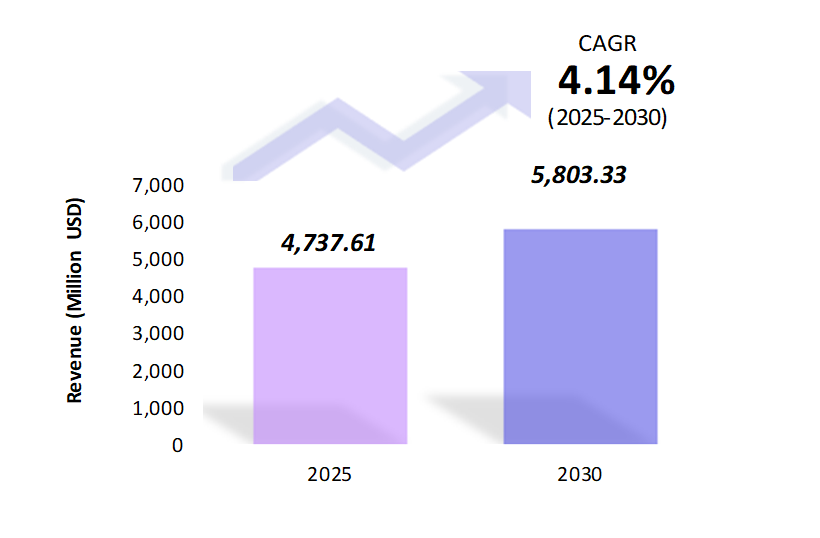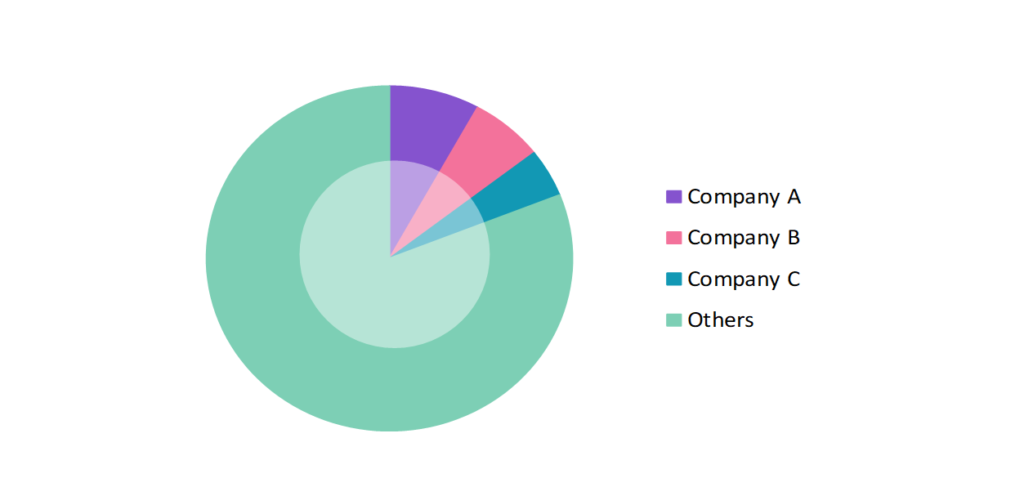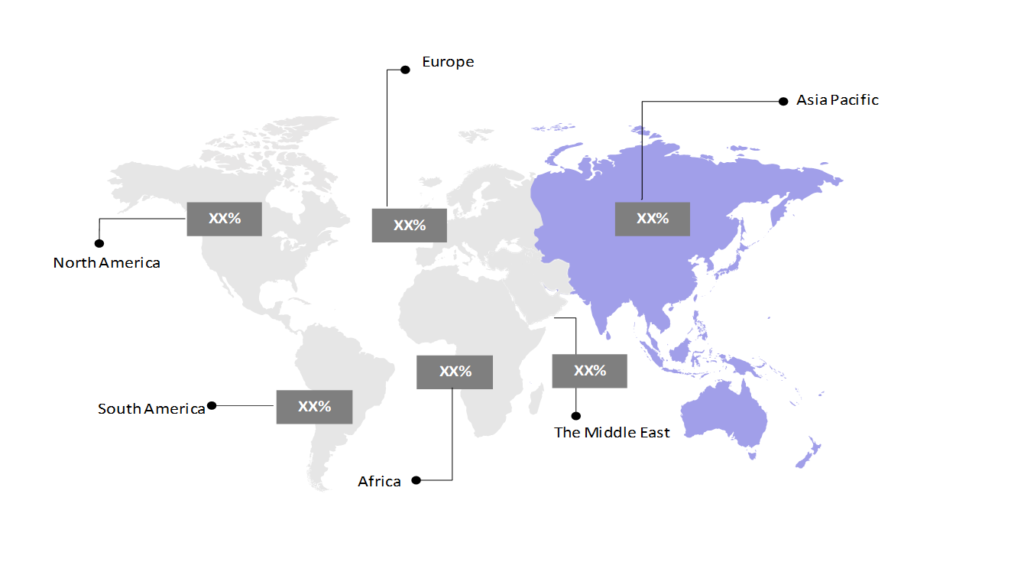Blower Market: Size, Share, Trends & Forecast (2024-2029)
The market report offers a detailed analysis segmented by Product (Positive Displacement Blowers, Centrifugal Blowers, High-speed Turbo Blowers, Regenerative Blowers); by End Use (Cement, Steel, Mining, Power, Chemicals & Petrochemical, Others); by Geography (North America, South America, Asia Pacific, Europe, The Middle East, Africa).
Outlook

- The blower market is estimated to be at USD 4,737.61 Mn in 2025 and is anticipated to reach USD 5,803.33 Mn in 2030.
- The blower market is registering a CAGR of 4.14% during the forecast period 2025-2030.
- The blower market is experiencing steady growth, driven by increased industrial automation and the expanding demand for energy-efficient solutions. Sectors such as wastewater treatment, HVAC, and food processing are key adopters due to their need for consistent airflow and low-pressure operations. However, challenges such as the availability of low-quality products and concerns over noise pollution in heavy industries remain. Despite these obstacles, advancements in smart technologies and sustainable designs are reshaping the market landscape.
Request a free sample.
Ecosystem

- The participants in the global blower industry are always developing their strategies to preserve a competitive advantage.
- Leading players are focusing on innovation by integrating smart technologies, energy-efficient designs, and noise-reduction features to differentiate their products. Customization based on industry-specific requirements, such as oil-free or low-pressure blowers, is a key competitive strategy.
- Several important entities in the blower market include Ingersoll Rand Inc.; Atlas Copco Group; AERZEN Group; Xylem Inc.; Kaeser Kompressoren SE; and others.
Ask for customization.
Findings
| Attributes | Values |
|---|---|
| Historical Period | 2019-2023 |
| Base Year | 2024 |
| Forecast Period | 2025-2030 |
| Market Size (2025) | USD 4,737.61 Mn |
| Market Size (2030) | USD 5,803.33 Mn |
| Growth Rate | 4.14% CAGR from 2025 to 2030 |
| Key Segments | Product (Positive Displacement Blowers, Centrifugal Blowers, High-speed Turbo Blowers, Regenerative Blowers); End Use (Cement, Steel, Mining, Power, Chemicals & Petrochemical, Others); Geography (North America, South America, Asia Pacific, Europe, The Middle East, Africa) |
| Key Vendors | Ingersoll Rand Inc.; Atlas Copco Group; AERZEN Group; Xylem Inc.; Kaeser Kompressoren SE |
| Key Countries | The US; Canada; Mexico; Brazil; Argentina; Colombia; China; India; Japan; South Korea; The UK; Germany; Italy; France; Turkey; UAE; Saudi Arabia; Egypt; South Africa |
| Largest Market | Asia Pacific |
Get a free quote.
Trends
- Energy-Efficient Blowers: Innovations in blower technology focus on reducing energy consumption through advanced motors and variable frequency drives (VFDs). These blowers adjust speed based on demand, which minimizes power usage. For instance, Atlas Copco’s ZS series of energy-efficient blowers claim up to 30% energy savings by optimizing performance for industrial applications.
- Oil-Free Blowers for Clean Environments: Oil-free blowers, designed for environments requiring contamination-free air, have become increasingly popular in industries like pharmaceuticals and food processing. Elmo Rietschle’s oil-free screw blowers provide clean air, which ensures compliance with hygiene standards, which is critical in sterile environments such as hospitals and food production.
- Smart Blowers with IoT Integration: Smart blowers equipped with IoT sensors can monitor real-time performance and predict maintenance needs. These blowers enhance operational efficiency by preventing unexpected failures. For example, Gardner Denver’s iConn platform connects blowers to cloud-based systems, which offer insights into system health and performance optimization in industries like wastewater treatment.
Speak to analyst.
Catalysts
- Increasing Government Initiatives to Promote Industrial Automation: Governments worldwide are pushing for increased industrial automation to enhance productivity and reduce energy consumption. Blowers, integral to automated systems like HVAC, wastewater treatment, and pneumatic conveying, benefit from these initiatives. For example, India’s “Make in India” campaign and China’s “Made in China 2025” aim to modernize industries by encouraging automation, driving the demand for efficient blowers in sectors like manufacturing and process industries.
- Rising Emphasis on Enhancing Coverage of Integrated Water Treatment Services: As water scarcity and pollution become global concerns, governments are prioritizing water treatment infrastructure, expanding the need for blowers in wastewater management. Integrated water treatment services require energy-efficient blowers for aeration in wastewater plants. For instance, the US EPA’s Clean Water State Revolving Fund supports investments in wastewater infrastructure, directly increasing demand for blowers to ensure optimal aeration and treatment processes.
- Growing Adoption of Blowers for Low-Pressure Operations: Blowers designed for low-pressure applications are gaining traction in industries that require controlled airflow, such as food processing, pharmaceuticals, and wastewater treatment. Tetra Pak, a company in food processing and packaging, uses low-pressure blowers in its manufacturing processes to provide controlled airflow during the packaging of liquid foods like juices and dairy products. These blowers ensure a consistent supply of air, which is crucial for maintaining the quality and safety of the products while preventing contamination.
Inquire before buying.
Restraints
- Availability of Low-Quality and Cheap Products in the Gray Market: The presence of counterfeit or substandard blowers in the gray market poses a significant challenge for reputable manufacturers. These low-quality products often fail to meet industry standards, which leads to inefficiencies, frequent breakdowns, and increased maintenance costs for end-users. Industries may face operational issues when using cheaper blowers that lack the durability and performance of certified models.
- Health Risks Associated with Noise Pollution in Heavy Industries: Blowers used in heavy industries, such as mining and manufacturing, can generate high levels of noise, which leads to health risks such as hearing loss and stress for workers. This noise pollution is increasingly concerning, particularly in environments governed by stringent health and safety regulations. As a result, companies are facing mounting pressure to invest in noise-reduction technologies to protect their workforce and comply with regulatory standards.
- High Risk Associated with Air Leaks and Equipment Downtime: Air leaks and equipment downtime are critical challenges in industries relying on continuous blower operation, such as water treatment and manufacturing. Air leaks can lead to significant inefficiencies, higher energy consumption, and increased operational costs. Additionally, equipment downtime caused by blower malfunctions can disrupt production processes, which results in delays and financial losses. A failure in a blower system during wastewater aeration can hinder treatment processes, which leads to regulatory penalties.
Personalize this research.
Hotspot

Explore purchase options.
Table of Contents
| 1. Introduction 1.1. Research Methodology 1.2. Scope of the Study 2. Market Overview / Executive Summary 2.1. Global Blower Market (2019 – 2023) 2.2. Global Blower Market (2024 – 2030) 3. Market Segmentation 3.1. Global Blower Market by Product 3.1.1. Positive Displacement Blowers 3.1.2. Centrifugal Blowers 3.1.3. High-speed Turbo Blowers 3.1.4. Regenerative Blowers 3.3. Global Blower Market by End Use 3.3.1. Cement 3.3.2. Steel 3.3.3. Mining 3.3.4. Power 3.3.5. Chemicals & Petrochemical 3.3.6. Others 4. Regional Segmentation 4.1. North America 4.1.1. The US 4.1.2. Canada 4.1.3. Mexico 4.2. South America 4.2.1. Argentina 4.2.2. Colombia 4.2.3. Rest of South America 4.3. Asia Pacific 4.3.1. China 4.3.2. India 4.3.4. Rest of Asia Pacific 4.4. Europe 4.4.1. The UK 4.4.2. Germany 4.4.3. Rest of Europe 4.5. The Middle East 4.5.1. Turkey 4.5.2. UAE 4.5.4. Rest of the Middle East 4.6. Africa 4.6.1. Egypt 4.6.2. South Africa 4.6.3. Rest of Africa 5. Value Chain Analysis of the Global Blower Market 6. Porter Five Forces Analysis 6.1. Threats of New Entrants 6.2. Threats of Substitutes 6.3. Bargaining Power of Buyers 6.4. Bargaining Power of Suppliers 6.5. Competition in the Industry 7. Trends, Drivers and Challenges Analysis 7.1. Market Trends 7.1.1. Market Trend 1 7.1.2. Market Trend 2 7.1.3. Market Trend 3 7.2. Market Drivers 7.2.1. Market Driver 1 7.2.2. Market Driver 2 7.2.3. Market Driver 3 7.3. Market Challenges 7.3.1. Market Challenge 1 7.3.2. Market Challenge 2 7.3.3. Market Challenge 3 8. Opportunities Analysis 8.1. Market Opportunity 1 8.2. Market Opportunity 2 8.3. Market Opportunity 3 9. Competitive Landscape 9.1. Ingersoll Rand Inc. 9.2. Atlas Copco Group 9.3. AERZEN Group 9.4. Xylem Inc. 9.5. Kaeser Kompressoren SE 9.6. Company 6 9.7. Company 7 9.8. Company 8 9.9. Company 9 9.10. Company 10 |
Know the research methodology.
Blower Market – FAQs
1. What is the current size of the blower market?
Ans. In 2025 the blower market size is USD 4,737.61 Mn.
2. Who are the major vendors in the blower market?
Ans. The major vendors in the blower market are Ingersoll Rand Inc.; Atlas Copco Group; AERZEN Group; Xylem Inc.; Kaeser Kompressoren SE.
3. Which segments are covered under the blower market segments analysis?
Ans. The blower market report offers in-depth insights into Product, End Use, and Geography.
